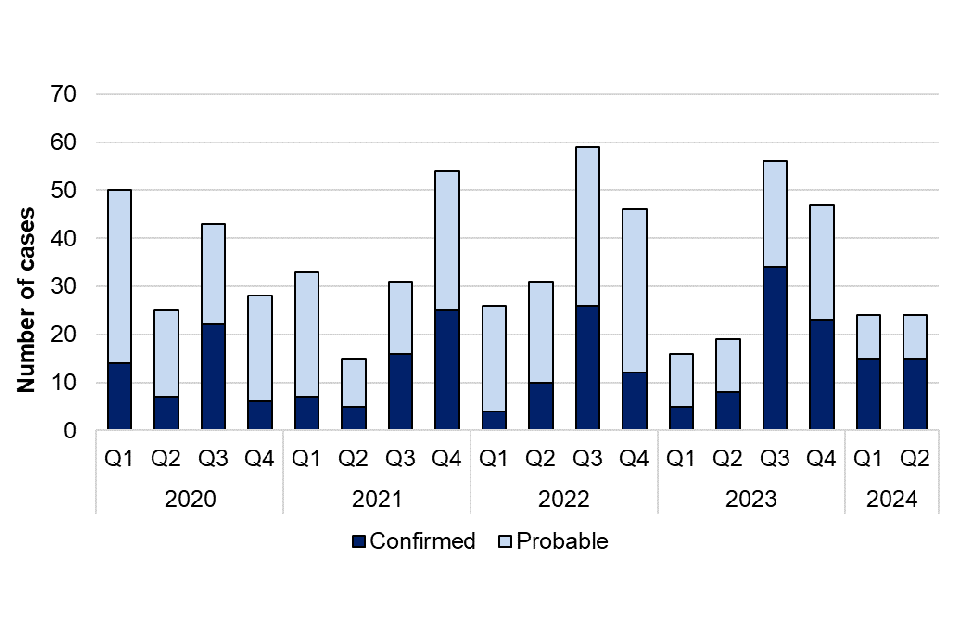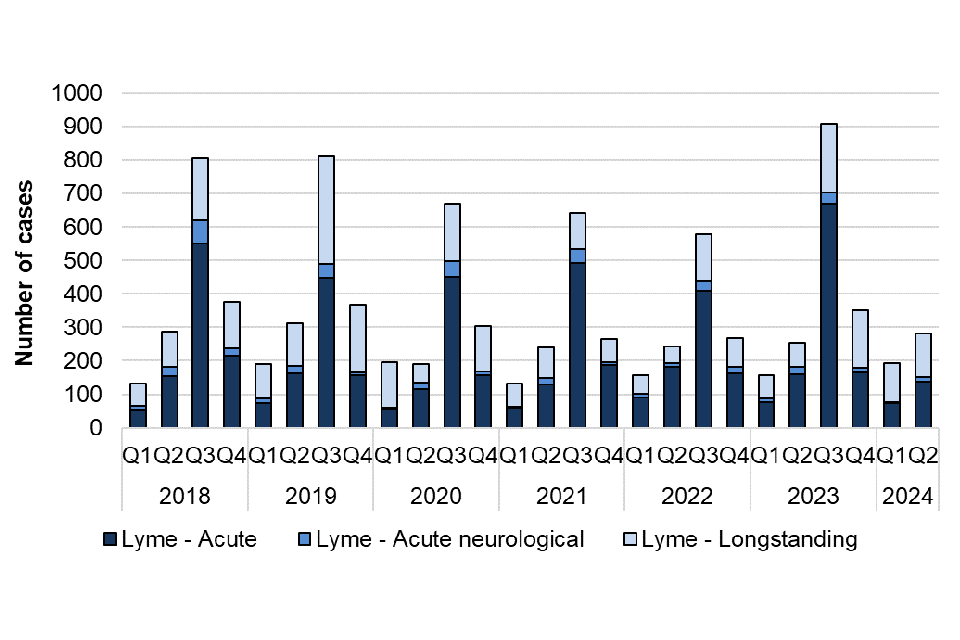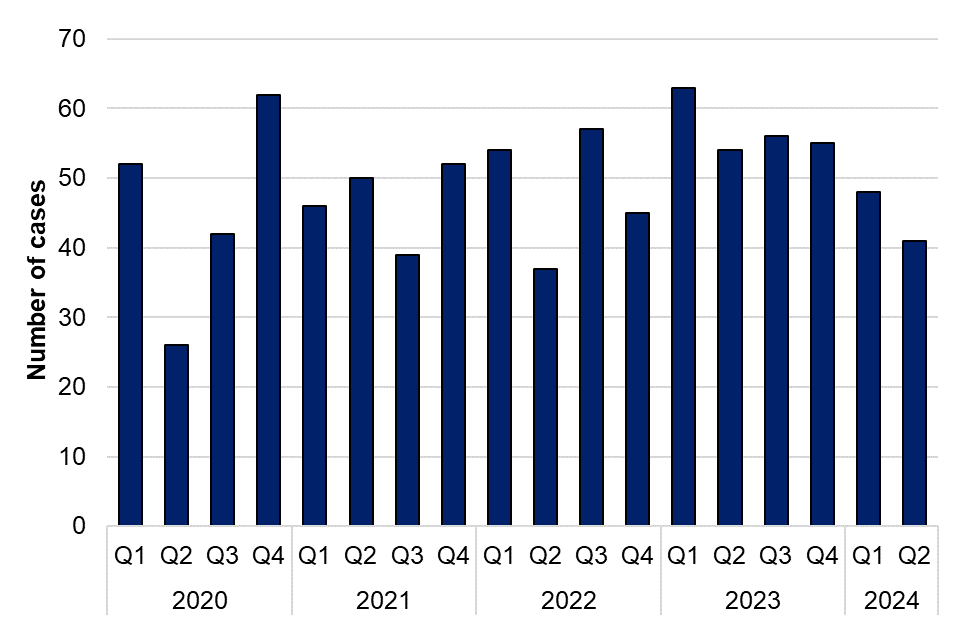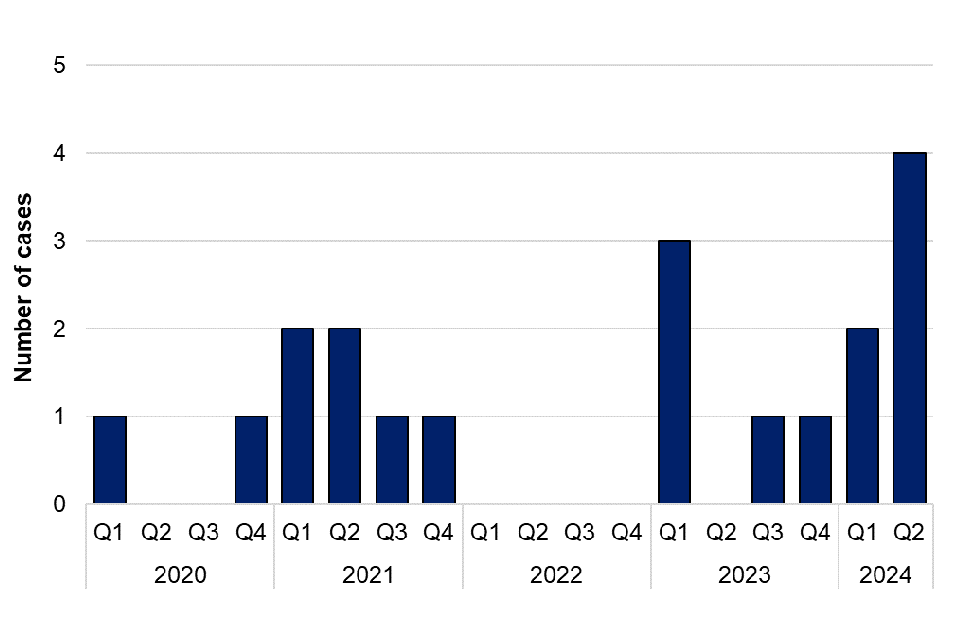Common animal-associated infections (England): second quarter 2024
Updated 31 October 2024
Applies to England
Background
This quarterly report is produced by the Emerging Infections and Zoonoses team in the Travel Health, Zoonosis, Emerging Infections, Respiratory and TB Division, Clinical and Emerging Infections Directorate, UK Health Security Agency (UKHSA). As of 2023, the data presented in these reports is for England only. Data for Wales will be reported separately by Public Health Wales. Previous reports presenting data for both England and Wales can be found elsewhere on the GOV.UK website.
The report summarises laboratory-diagnosed cases of selected zoonoses reported in England between April and June 2024 (second quarter) and includes additional information on the quarterly trends for hepatitis E, leptospirosis, Lyme disease, toxoplasmosis, psittacosis, and toxigenic Corynebacterium ulcerans.
It is important to note that not all cases of a zoonotic infection will present to healthcare services, and some cases may be treated empirically based on clinical suspicion without the need for a confirmatory test. Therefore, the numbers in this report are expected to be an underestimate of the true burden of zoonotic disease in England, likely biasing towards severe infections as individuals with severe or symptomatic disease may be more likely to be tested. Furthermore, not all zoonoses presented in this report are notifiable in England. As such, it is likely not all confirmed laboratory test results are reported to UKHSA. For a list of notifiable diseases and causative organisms in England see the Notifiable diseases and causative organisms: how to report webpage.
The impacts of the public health measures implemented in England due to the COVID-19 pandemic during 2020 and 2021 should be considered when making comparisons with this time period.
Data reported as provisional is subject to change due to late notifications and de-duplication. Therefore, the data presented in this report supersedes data in previous reports.
The regional data presented is based on the location of the patient postcode where available. If patient postcode is not available, then location of the referring hospital or laboratory is used. This means the regional data presented does not necessarily reflect the geographic area where the cases are located or the infection is acquired.
Q-fever data is not presented in this quarterly report. As part of an internal review, the data is being validated and will be published as soon as possible.
Overview
Table 1. Animal-associated infections in England: quarterly confirmed laboratory reports by specimen date Q1 2022 to Q2 2024
| Disease (Organism) | Q1 2022 | Q2 2022 | Q3 2022 | Q4 2022 | Total 2022 | Q1 2023 | Q2 2023 | Q3 2023 | Q4 2023 | Total 2023 | Q1 2024 | Q2 2024* |
|---|---|---|---|---|---|---|---|---|---|---|---|---|
| Anthrax (Bacillus anthracis) | 0 | 0 | 0 | 0 | 0 | 0 | 0 | 0 | 0 | 0 | 0 | 0 |
| Brucellosis (Brucella spp.) ** | 1 | 3 | 4 | 5 | 13 | 2 | 7 | 9 | – | – | – | – |
| Hepatitis E | 322 | 397 | 343 | 457 | 1,519 | 379 | 385 | 409 | 356 | 1,529 | 366 | 377 |
| Leptospirosis (Leptospira spp.) | 4 | 10 | 26 | 12 | 52 | 5 | 8 | 34 | 23 | 70 | 15 | 15 |
| Lyme disease (Borrelia burgdorferi) | ||||||||||||
| All cases | 157 | 243 | 577 | 269 | 1,246 | 158 | 253 | 908 | 351 | 1,670 | 194 | 281 |
| Acute infections | 101 | 192 | 441 | 182 | 916 | 87 | 183 | 704 | 180 | 1,154 | 77 | 151 |
| Pasteurellosis (Pasteurella spp.) | 173 | 214 | 230 | 184 | 801 | 151 | 222 | 255 | 187 | 815 | 219 | 205 |
| Chlamydia psittaci / Chlamydia abortus | 0 | 0 | 0 | 0 | 0 | 3 | 0 | 1 | 1 | 5 | 2 | 4 |
| Toxigenic Corynebacterium ulcerans | 3 | 1 | 4 | 3 | 11 | 3 | 1 | 3 | 4 | 11 | 2 | 1 |
| Toxoplasmosis (Toxoplasma gondii)† | 54 | 37 | 57 | 45 | 193 | 63 | 54 | 56 | 55 | 228 | 48 | 41 |
*Provisional data.
**Data has not been included in this report since Quarter 3 2023 due to an ongoing review of recent results in collaboration with the Brucella reference laboratory. This data will be published once this review is complete.
† Based on date specimen received.
Hepatitis E
Hepatitis E virus (HEV) surveillance reports reference laboratory data (Public Health Laboratory Birmingham and the UKHSA Blood Borne Virus Unit Colindale) together with additional cases reported by local laboratories through the Second Generation Surveillance System (SGSS). The combined data sets provide a more accurate reflection of the number of acute HEV cases reported in England.
There were 377 laboratory-reported cases of HEV infection in the second quarter of 2024 compared with 385 in the same quarter of 2023. Figure 1 shows the number of HEV infections by quarter between 2020 and 2024. There is a trend of cases increasing annually with no discernible seasonality.
Figure 1. Laboratory-confirmed cases of hepatitis E in England by quarter, Q1 2020 to Q2 2024

Of the 377 cases reported in the second quarter of 2024, 217 (58%) were male (aged 2 to 91 years, median 58 years) and 160 (42%) were female (aged 4 to 94 years, median 53 years) (Table 2). There is a persisting predominance of middle aged and older men (aged 45 years and over), with 41% of total cases this quarter in this category.
Table 2. Laboratory-confirmed cases of hepatitis E in England by age group and sex, Q2 2024
| Age group (years) | Male | Female | Total |
|---|---|---|---|
| 0 to 14 | 5 | 3 | 8 |
| 15 to 24 | 17 | 14 | 31 |
| 25 to 44 | 41 | 48 | 89 |
| 45 to 64 | 80 | 42 | 122 |
| Over 64 | 74 | 53 | 127 |
| Total | 217 | 160 | 377 |
Leptospirosis
Data for leptospirosis was obtained from the Rare and Imported Pathogens Laboratory (RIPL, UKHSA Porton). As of 1 August 2020, a laboratory-confirmed case of leptospirosis is defined by a positive 16S ribosomal ribonucleic acid (rRNA) polymerase chain reaction (PCR) result only. An Immunoglobulin M (IgM) enzyme-linked immunoabsorbent assay (EIA) continues to be performed on all samples of suspected leptospirosis cases. A case with a positive leptospirosis IgM result will usually be treated clinically on the basis of this result, even in the absence of a positive PCR result. A case with a positive IgM but without a confirmatory PCR result is therefore reported as a probable case for surveillance purposes. National surveillance of probable cases of leptospirosis was introduced in 2021.
There were 15 confirmed cases and 9 probable cases of leptospirosis reported in the second quarter of 2024, compared with 8 confirmed and 11 probable cases reported in the same quarter of 2023. Figure 2 shows the number of confirmed and probable cases reported by quarter over the past 5 years (2020 to 2024).
Figure 2. Laboratory-confirmed cases of leptospirosis in England by quarter, Q1 2020 to Q2 2024

In the second quarter of 2024, 10 (67%) confirmed cases were male (aged 22 to 63 years, median 48 years) and 5 (33%) were female (aged 28 to 59, median 39 years). Based on patient postcode, or reporting laboratory location where patient postcode was missing, cases were reported in the South West (n=5), South East (n=3), the London region (n=3), East of England (n=2), West Midlands (n=1), and Yorkshire and Humber (n=1).
Table 3. Laboratory-confirmed cases of leptospirosis in England by age group and sex, Q2 2024
| Age group (years) | Male | Female | Total |
|---|---|---|---|
| 0 to 14 | 0 | 0 | 0 |
| 15 to 24 | 1 | 0 | 1 |
| 25 to 44 | 3 | 3 | 6 |
| 45 to 64 | 6 | 2 | 8 |
| Over 64 | 0 | 0 | 0 |
| Total | 10 | 5 | 15 |
Travel history is not always available for laboratory diagnosed cases and the reported country of recent travel does not necessarily reflect where the infection was acquired. Of the confirmed cases, 4 reported recent travel abroad. These included travel to Southeast Asia (n=2), South and Central America (n=1), and Western Europe (n=1).
Of the 15 confirmed cases, 3 reported potential exposure to a water source: 2 reported open water swimming, and 1 confirmed case reported water exposure which was unspecified. One case reported being bitten by a rat as a potential exposure. It should be noted that exposure information is not well reported by cases and may reflect potential exposures in the UK or abroad.
Lyme disease
Data for Lyme disease was obtained from the Rare and Imported Pathogens Laboratory (RIPL, UKHSA Porton). The total number of confirmed Lyme disease cases reported in the second quarter of 2024 (n=281) was higher than in the same time period in 2023 (n=253); however, the total number of acute cases reported was lower in the second quarter of 2024 (n=151) compared with the same period in 2023 (n=183). The recent number of cases reported are similar to data reported in 2018/2019, prior to a decrease in cases during COVID-19 when there was a reduction in laboratory-confirmed cases, possibly due to cases being treated without being tested. It should be noted that diagnosis for acute Lyme disease presenting with erythema migrans (“bullseye rash”) is made clinically and testing is not recommended, as per NICE guidelines. The number of laboratory-confirmed cases presented in this report are therefore likely an under-estimate of the true burden of acute Lyme disease in England.
Figure 3 shows how the number of cases continues to peak during the summer months (third quarter), which corresponds to the peak period of exposure to ticks in the UK, the spring and summer months. Data for this quarter reflects an increase in cases between winter and spring, following a similar trend from previous years.
Figure 3. Laboratory-confirmed cases of Lyme disease in England by quarter, Q1 2018 to Q2 2024

Of the 281 total cases reported in the second quarter, 151 (54%) were acute (including 12 with neurological Lyme disease) and 130 (46%) were longstanding.
Of the acute cases, 76 (50%) were male (aged 1 to 81 years, median 54 years), 71 (47%) were female (aged 2 to 78 years, median 46 years), and there were 4 (3%) cases where sex was unknown (aged 23 to 70, median 60 years). Table 4 shows the age group and sex distribution of acute cases.
Table 4. Laboratory-confirmed acute cases of Lyme disease in England by age group and sex, Q2 2024
| Age group (years) | Male | Female | Unknown | Total |
|---|---|---|---|---|
| 0 to 14 | 6 | 8 | 0 | 14 |
| 15 to 24 | 2 | 1 | 1 | 4 |
| 25 to 34 | 7 | 14 | 0 | 21 |
| 35 to 44 | 9 | 9 | 0 | 18 |
| 45 to 54 | 16 | 10 | 1 | 27 |
| 55 to 64 | 21 | 16 | 0 | 37 |
| 65 to 74 | 9 | 10 | 2 | 21 |
| Over 74 | 6 | 3 | 0 | 9 |
| Total | 76 | 71 | 4 | 151 |
The regions that reported the most acute cases in the second quarter of 2024 were the South West (n=39), the South East (n=38), and London (n=32) (Table 5). This data is based on the patient’s postcode where available. Where patient postcode is not available, the location of the referring hospital or laboratory is used. As such, location of cases does not necessarily reflect the geographic area where the tick bite occurred.
Travel history is not always available for laboratory-diagnosed cases and the reported country of recent travel does not necessarily reflect where the infection was acquired. Of the 151 acute cases in the second quarter of 2024, 7 reported foreign travel; 4 cases reported travel to Europe, 1 case reported travel to South America, 1 case reported travel to North America, and 1 case had travelled to the Middle East.
Table 5. Laboratory-confirmed acute cases of Lyme disease in England by centre, Q1 2022 to Q2 2024
| UKHSA Region | Q1 2022 | Q2 2022 | Q3 2022 | Q4 2022 | Total 2022 | Q1 2023 | Q2 2023 | Q3 2023 | Q4 2023 | Total 2023 | Q1 2024 | Q2 2024 |
|---|---|---|---|---|---|---|---|---|---|---|---|---|
| East Midlands | 5 | 5 | 6 | 7 | 23 | 1 | 0 | 22 | 4 | 27 | 4 | 4 |
| East of England | 6 | 14 | 25 | 19 | 64 | 3 | 8 | 27 | 8 | 46 | 10 | 8 |
| London | 21 | 31 | 69 | 34 | 155 | 16 | 28 | 120 | 42 | 206 | 18 | 32 |
| North East | 2 | 3 | 15 | 6 | 26 | 3 | 2 | 23 | 12 | 40 | 2 | 6 |
| North West | 13 | 12 | 28 | 16 | 69 | 10 | 10 | 47 | 12 | 79 | 8 | 16 |
| South East | 25 | 61 | 136 | 46 | 268 | 25 | 63 | 195 | 50 | 333 | 15 | 38 |
| South West | 18 | 56 | 114 | 35 | 223 | 18 | 55 | 202 | 32 | 307 | 12 | 39 |
| West Midlands | 5 | 1 | 22 | 5 | 33 | 4 | 11 | 27 | 9 | 51 | 3 | 5 |
| Yorkshire and Humber | 5 | 9 | 26 | 14 | 54 | 7 | 6 | 41 | 11 | 65 | 5 | 3 |
| Unknown | 1 | 0 | 0 | 0 | 1 | 0 | 0 | 0 | 0 | 0 | 0 | 0 |
| Total | 101 | 192 | 441 | 182 | 916 | 87 | 183 | 704 | 180 | 1,154 | 77 | 151 |
Toxoplasmosis
Data for toxoplasmosis in England is obtained from the Toxoplasma Reference Unit (TRU, Public Health Wales Swansea). There was a total of 41 confirmed toxoplasmosis cases reported in the second quarter of 2024
Figure 4. Laboratory-confirmed cases of toxoplasmosis in England by quarter, Q1 2020 to Q2 2024

Of the total confirmed cases, 15 (37%) were male (aged 0 to 83, median 26 years), 26 (63%) were female (aged 16 to 59, median 31 years), including 1 female case where age was unknown. Table 6 shows the age group and sex distribution.
Table 6. Laboratory-confirmed cases of toxoplasmosis in England by age group and sex, Q2 2024
| Age group (years) | Male | Female | Total |
|---|---|---|---|
| 0 to 14 | 3 | 0 | 3 |
| 15 to 24 | 3 | 2 | 5 |
| 25 to 44 | 5 | 15 | 20 |
| 45 to 64 | 0 | 8 | 8 |
| Over 65 | 4 | 0 | 4 |
| Unknown | 0 | 1 | 1 |
| Total | 15 | 26 | 41 |
Chlamydia psittaci / Chlamydia abortus
Data for C. psittaci / C. abortus was obtained from the Respiratory and Vaccine Preventable Bacteria Reference Unit (RVPBRU) in Colindale and from cases reported by local laboratories through SGSS. As of 1 January 2023, a confirmed case of psittacosis is defined by a positive 16S rRNA PCR result or culture isolation only.
It should be noted that the existing PCR assay is unable to differentiate between C. psittaci and C. abortus. However, as there are currently no other reliable methods of psittacosis identification, the numbers presented in these reports will reflect laboratory-confirmed cases with a positive PCR result for C. psittaci / C. abortus.
There were 4 reports of C. psittaci / C. abortus in the second quarter of 2024. Two cases were male (aged 58 to 68, median age 63), and 2 cases were female (aged 8 to 59, median age 33), spread across four UKHSA regions (Table 7). Figure 5 shows the number of laboratory confirmed cases of C. psittaci / C. abortus between 2020 and 2024.
Table 7. Laboratory confirmed acute cases of C. psittaci / C. abortus in England by UKHSA region, Q2 2024
| UKHSA Region | Number of C. psittaci / C. abortus cases |
|---|---|
| East Midlands | 1 |
| East of England | 1 |
| North West | 1 |
| South West | 1 |
| Total | 4 |
Figure 5. Laboratory-confirmed cases of Chlamydia psittaci / Chlamydia abortus in England by quarter, Q1 2020 to Q2 2024

Toxigenic Corynebacterium ulcerans
Toxigenic Corynebacterium ulcerans (C. ulcerans), is a zoonotic pathogen that can cause diphtheria in humans.
Laboratory confirmation of toxigenic C. ulcerans is obtained from the Respiratory and Vaccine Preventable Bacteria Reference Unit (RVPBRU) in Colindale. A confirmed case of toxigenic C. ulcerans infection is defined by isolation of C. ulcerans that is positive for the diphtheria toxin gene by PCR and that expresses the toxin (as demonstrated using the Elek test). C. ulcerans speciation is initially established by the submitting laboratory and then confirmed in RVPBRU using a combination of species-specific PCR, additional biochemical testing and MALDI-TOF MS, as required.
There was 1 report of toxigenic C. ulcerans infection in the second quarter of 2024, with no reported contact with companion animals, this is the same as the number of cases reported in the second quarter of 2023 (n=1). Figure 6 shows the number of cases of C. ulcerans by quarter since 2022.
In England, contact with companion animals remains the most frequently reported exposure for individuals with confirmed toxigenic C. ulcerans infections. However, the animals may not show evidence of infection and it is not always possible to confirm the carriage of C. ulcerans in animals.
Figure 6. Laboratory confirmed acute cases of toxigenic C. ulcerans in England by quarter, Q1 2022 to Q2 2024

Other zoonotic organisms
Data for other zoonotic organisms are obtained from cases reported by local laboratories through SGSS. The region is based on the patient postcode where available. If the patient’s postcode is not available, then the location of the referring hospital or laboratory is used.
There were 21 reports of Capnocytophaga spp. infection in the second quarter of 2024. Of the cases reported this quarter, 18 were further speciated to Capnocytophaga canimorsus, 1 was Capnocytophaga ochracea and 1 was Capnocytophaga other named. Of those speciated to Capnocytophaga canimorsus, 10 cases were male and 8 were female, and cases were reported in East of England (n=1), South East (n=4), South West (n=8), Yorkshire and Humber (n=3), and West Midlands (n=2). Capnocytophaga spp. are frequently carried in the mouths of companion animals (cats and dogs) or humans and may be associated with an animal or human bite, or opportunistic infections in those with impaired immune systems.
There were 2 reports of Mycobacterium marinum infection in the second quarter of 2024. Both cases were male, and were reported in the North East (n=1) and Yorkshire and Humber (n=1).
There was 1 report of Erysipelothrix rhusiopathiae in the second quarter of 2024; the case was male and was located in the South West.
There were 6 reports of Taeniasis in the second quarter of 2024. Of the cases reported this quarter, 1 was further speciated to T. saginata.
There were no reports of Toxocariasis in the second quarter of 2024.
